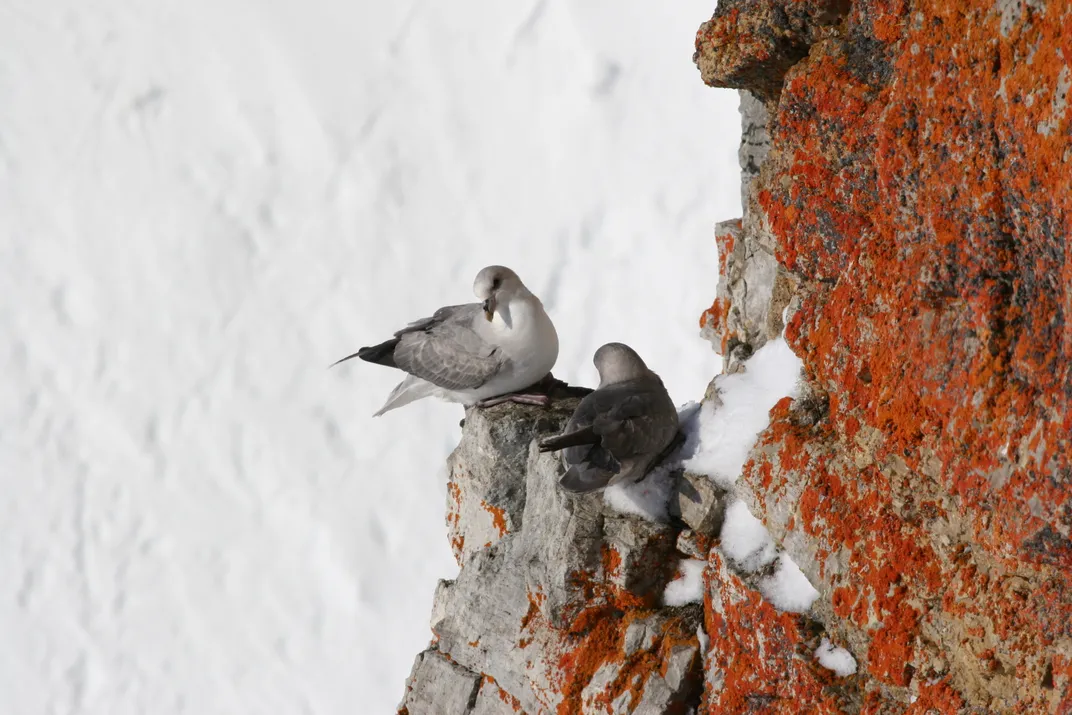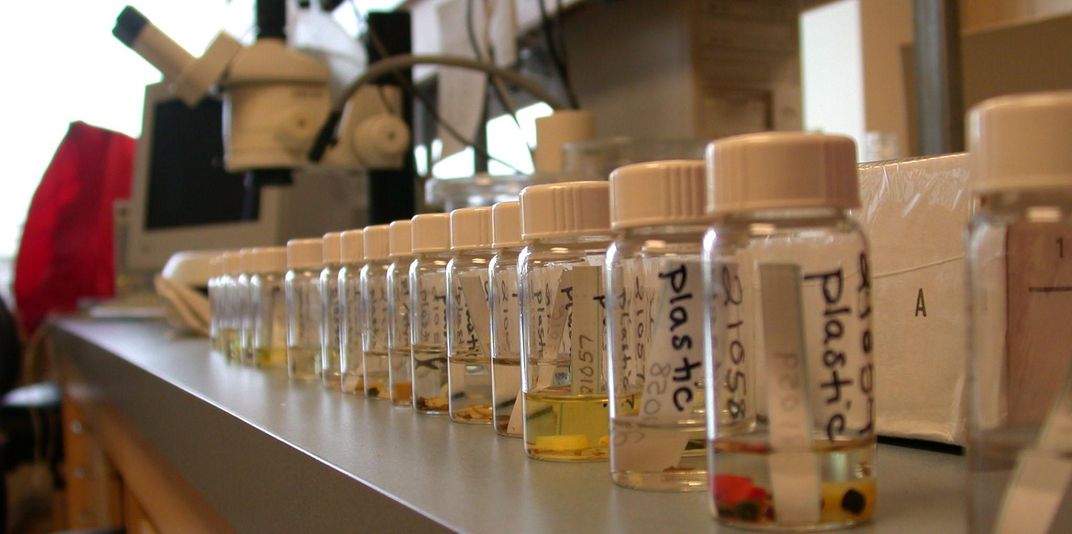Seabirds Are Dumping Pollution-Laden Poop Back on Land
Chemicals we’ve poured into the ocean are coming back to sting us thanks to seabirds defecating in their onshore colonies
/https://tf-cmsv2-smithsonianmag-media.s3.amazonaws.com/filer/a1/75/a1752a71-a2d2-4a62-be29-637bd5621f33/murres_on_cliffs.jpg)
Mark Mallory was in a helicopter flying over the bleak Arctic tundra when he was struck by the view of Cape Vera on Devon Island. He had been flying over blue water and brown landscapes in Nunavut for some time, so the bright orange 1,000-foot cliffs towering over green ponds were a sight for sore eyes.
“The green and orange contrast when you’re coming in from the air is unbelievably beautiful,” says the Canada research chair and associate biology professor at Acadia University in Nova Scotia. Mallory was interested in studying northern fulmars, seabirds related to petrels that nest in the tens of thousands on the cliffs of this uninhabited island.
The lichen on the cliffs and the moss in the small freshwater pools underneath them got him thinking about what the birds were doing to the island.
“You get relatively lush conditions. It’s like an oasis,” he says. That's because the birds are enriching the land with their poop, which is filled with nutrients including nitrogen and phosphorous. “That’s a natural process that happens anywhere in the world where you’ve got a concentration of seabirds.”
What he found, though, is that nutrients weren’t the only thing these birds were bringing back from the sea—the colonies also are contaminant hotspots.
It’s well documented how human activities are causing toxic algae blooms, dead zones and islands of floating plastic in the ocean. The Ocean Conservancy recently released a report that found that by 2025 there could be one ton of plastic in the ocean for every three tons of fish, while factories and farms create runoff filled with DDT, PCBs and mercury that finds its way into the ocean.
What is less documented is how these plastics and chemicals are coming back to land. The contaminants get absorbed by plankton and other ocean microbes, which are then eaten by fish or larger creatures. At every step up the food chain, the chemicals tend to “bio-magnify,” Mallory says, accumulating and concentrating in their bodies.
His studies found that fulmars are like the great cleaners of the ocean, ingesting a lot of plastic as well as chemicals that sometimes adhere to plastic. When the birds get back to Cape Vera, they vomit or defecate onto the cliffs, and the contaminants are then washed down into the freshwater pools beneath.
The nutrients from the fulmar guano bring algae and moss but also attract small midges and other aquatic insects—a tasty snack for snow buntings, largely terrestrial birds that will feed the bugs to their chicks.

This would be great for the birds if the insects didn’t hide a secret. Mallory says that the levels of DDT in the sediments of these ponds are relatively high, and the insects that live in them absorb some of the chemicals.
“It’s a trap. [The snow buntings] come thinking this is an abundant food supply, but it’s also relatively contaminated,” he says.
“We may think of the Arctic as this remote, pristine region, but it’s not,” adds Jennifer Provencher, a graduate student in eco-toxicology at Carleton University in Canada who frequently collaborates with Mallory. Provencher has found plastic and chemicals in the stomachs and livers of the thick-billed murres that live on the cliffs of Coats Island in the north of Hudson Bay. She has also found that great skuas can ingest plastic from preying on northern fulmars.
The winged predators aren’t the only things with an appetite for small birds. Provencher says that the Inuit in northern communities also eat murres. After harvesting the murres, they often throw the gizzards—where contaminants accumulate—to their dogs or into the local dump. That means the junk we dump into the oceans could be coming back to affect human health.

Veronica Padula studies one of the largest North American breeding colonies of seabirds, on the western Aleutian Islands off the Alaskan coast. She found that birds like kittiwakes, horned puffins and red-faced cormorants—the latter of particular concern because the population is dropping quickly—are absorbing large amounts of phthalates.
This group of chemicals is sometimes used to make plastic flexible or harder to break, and they can persist even after the plastics themselves break down in the ocean. While the effects of the chemicals aren't very well understood, the Centers for Disease Control and Prevention say that some types have affected the reproductive systems of laboratory animals.
“We don’t know if the birds excrete the chemicals through their feces,” says the Ph.D. student at the University of Alaska. "[But] it’s getting into their tissues, and if the bird dies on land, it’s definitely getting into the land.”
Padula has conducted studies that show that some of these birds have phthalates in their reproductive tissue, and she believes it’s likely that the chemicals are getting into the eggs themselves. So phthalates could be ingested by animals that eat the birds and their eggs, like foxes, invasive rats or eagles. Some people also harvest the eggs of kittiwakes and other birds on islands in the Bering Sea.
Padula says that while humans are exposed to phthalates from any number of other sources, “that interaction between seabirds and humans can be a very direct link between the way these contaminants can move onto land and impact people.”
And the return of oceanic pollution doesn’t only occur in remote areas. Mallory studied how other industrial chemicals like selenium, cadmium and zinc are turning up in relatively high levels in the soil of seabird-inhabited islands off the coast of Nova Scotia. Other recent research found that three species of commonly hunted gamebirds were ingesting significant levels of metals and plastics while hanging out in coastal areas, then bringing those contaminants back to freshwater wetlands, where people shoot the birds for food.
“It’s actually quite scary, especially when you start looking at what these chemicals do,” Padula says. “You kind of want to find a bunker and hide.”
/https://tf-cmsv2-smithsonianmag-media.s3.amazonaws.com/accounts/headshot/joshua-learn_copy.jpg)
/https://tf-cmsv2-smithsonianmag-media.s3.amazonaws.com/accounts/headshot/joshua-learn_copy.jpg)